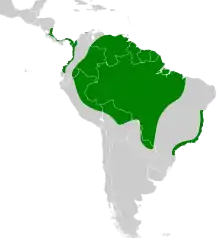Green-and-rufous kingfisher
The green-and-rufous kingfisher (Chloroceryle inda) is a resident breeding bird in the lowlands of the American tropics from southeastern Nicaragua south to southern Brazil.
| Green-and-rufous kingfisher | |
|---|---|
.JPG.webp) | |
| On the Cristalino River, Southern Amazon, Brazil | |
| Scientific classification | |
| Kingdom: | Animalia |
| Phylum: | Chordata |
| Class: | Aves |
| Order: | Coraciiformes |
| Family: | Alcedinidae |
| Subfamily: | Cerylinae |
| Genus: | Chloroceryle |
| Species: | C. inda |
| Binomial name | |
| Chloroceryle inda (Linnaeus, 1766) | |
 | |
| Synonyms | |
|
Alcedo inda Linnaeus, 1766 | |
Taxonomy
The first formal description of the green-and-rufous kingfisher was by the Swedish naturalist Carl Linnaeus in 1766 in the 12th edition of his Systema Naturae. He coined the binomial name Alcedo inda.[2] Linnaeus based his description on George Edwards's "Spotted King's-Fisher" but mistakenly gave the type locality as India occidentali instead of Guiana.[2][3][4] Linnaeus's specific name inda is from the Latin Indus for India.[5] The current genus Chloroceryle was erected by Johann Jakob Kaup in 1848.[6]
A molecular phylogenetic study published in 2006 found that the green-and-rufous kingfisher was a sister species to the smaller green kingfisher (Chloroceryle americana).[7]
Two subspecies are recognised:[8]
- C. i. inda (Linnaeus, 1766) – Nicaragua to northern Bolivia, southeastern Brazil
- C. i. chocoensis Todd, 1943 – western Colombia, northwestern Ecuador
Description
The green-and-rufous kingfisher is 24 cm (9.4 in) in length. Males weigh 46–60 g (1.6–2.1 oz) and females 53–62 g (1.9–2.2 oz). It has the typical kingfisher shape, with a short tail and long bill. The adult male has glossy green upperparts, with white spotting on the wings, and a rufous nape and underparts. The female has a narrow breast band of green-tipped white feathers. Young birds resemble the adult female, but have more spotting on the wings and back. The eyes are dark brown; the legs and feet are dark grey.[9]
The call a chip-chip-chip and some twittering.[10]
The green-and-rufous kingfisher resembles the American pygmy kingfisher, which shares its range, but it is much larger than its relative, and four times as heavy. It lacks the white lower belly shown by the smaller species, and has more white spots on the wings.[11]
The smaller green kingfisher and much larger Amazon kingfisher both have a white belly and collar.[12]
Distribution
Besides the Amazon Basin and the Guianas, also Colombia with most of Venezuela, (the Orinoco River basin), a disjunct range of the green-and-rufous kingfisher occurs on the southeast Brazil coast. A 200 km (120 mi) wide coastal range extends from central Bahia in the north to Santa Catarina, about 2,200 km (1,400 mi); a localized coastal population occurs north of Bahia in Pernambuco.
The population in Nicaragua, Costa Rica and Panama is also disjunct being west of the Andes cordillera; it is contiguous with a coastal population from central coastal Colombia south to central coastal Ecuador.
Behaviour
This kingfisher breeds by rivers and streams in dense lowland forests. The unlined nest is in a horizontal tunnel made in a river bank, and the female lays three to five white eggs.[13]
Green-and-rufous kingfishers are often seen perched on a branch above water before plunging in head first after their fish or crab prey.
References
- BirdLife International (2012). "Chloroceryle inda". IUCN Red List of Threatened Species. 2012. Retrieved 26 November 2013.CS1 maint: ref=harv (link)
- Linnaeus, Carl (1766). Systema naturae : per regna tria natura, secundum classes, ordines, genera, species, cum characteribus, differentiis, synonymis, locis (in Latin). Volume 1, Part 1 (12th ed.). Holmiae (Stockholm): Laurentii Salvii. p. 179.
- Edwards, George (1758–1764). Gleanings of natural history, exhibiting figures of quadrupeds, birds, insects, plants &c... (in English and French). Part 3. London: Printed for the author, at the College of Physicians. pp. 262–264, Plate 335.
- Peters, James Lee, ed. (1945). Check-list of Birds of the World. Volume 5. Cambridge, Massachusetts: Harvard University Press. p. 169.
- Jobling, James A. (2010). The Helm Dictionary of Scientific Bird Names. London: Christopher Helm. p. 204. ISBN 978-1-4081-2501-4.
- Kaup, Johann Jakob (1848). "Die Familie der Eisvögel (Alcedidae)". Verhandlungen des Naturhistorischen Vereins für das Großherzogthum Hessen und Umgebung (in German). 2: 68. OCLC 183221382.
- Moyle, Robert G (2006). "A molecular phylogeny of kingfishers (Alcedinidae) with insights into early biogeographic history". Auk. 123 (2): 487–499. doi:10.1642/0004-8038(2006)123[487:AMPOKA]2.0.CO;2. hdl:1808/16596.
- Gill, Frank; Donsker, David, eds. (2017). "Rollers, ground rollers & kingfishers". World Bird List Version 7.2. International Ornithologists' Union. Retrieved 28 May 2017.
- Fry, Fry & Harris 1992, pp. 225-226.
- Fry, Fry & Harris 1992, p. 225.
- Fry, Fry & Harris 1992, pp. 76, 225.
- Fry, Fry & Harris 1992, p. 76.
- Fry, Fry & Harris 1992, pp. 6, 17-18, 226.
Sources
External links
| Wikimedia Commons has media related to Chloroceryle inda. |
| Wikispecies has information related to Chloroceryle inda. |
- Xeno-canto: audio recordings of the green-and-rufous kingfisher
- "Green-and-rufous Kingfisher media". Internet Bird Collection.
- Stamps (for Suriname) with RangeMap
- Green-and-rufous Kingfisher photo gallery at VIREO (Drexel University)
- Green-and-rufous Kingfisher species account at Neotropical Birds (Cornell Lab of Ornithology)
